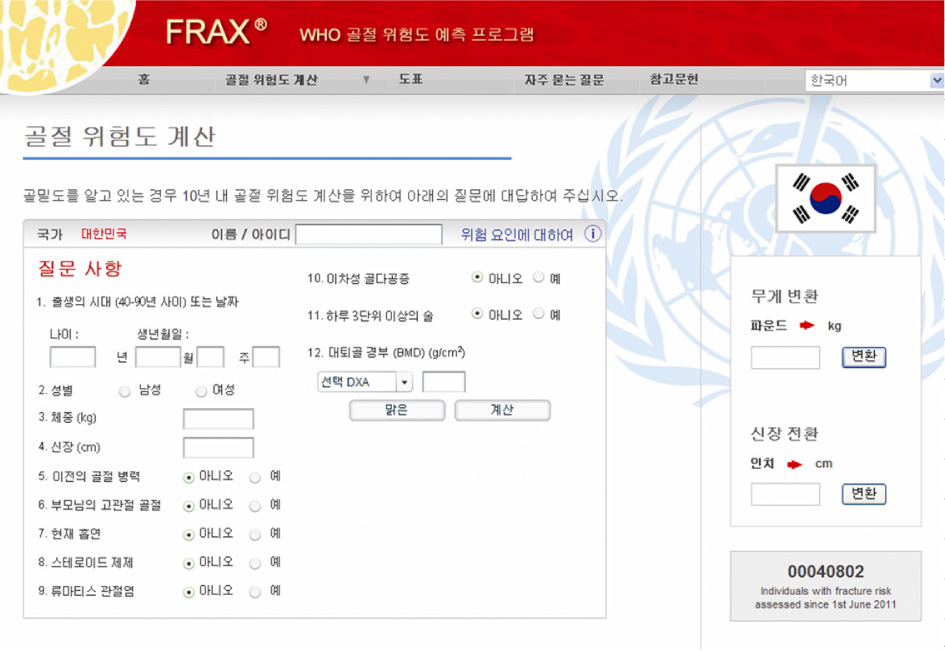Korean J Bone Metab.
2012 May;19(1):29-34. 10.11005/kjbm.2012.19.1.29.
Routine Application of the Korean FRAX Model in Women: a Single-center Study
- Affiliations
-
- 1Department of Obstetrics and Gynecology, College of Medicine, Soonchunhyang University, Bucheon, Korea. hhl22@schmc.ac.kr
- KMID: 1464233
- DOI: http://doi.org/10.11005/kjbm.2012.19.1.29
Abstract
OBJECTIVES
The objective of this study was to assess the efficacy of the Korean fracture-risk assessment tool (FRAX) model for routine application in women who had a general check-up for bone mineral density (BMD).
METHODS
This retrospective study was conducted at a university hospital and comprised 343 patients, whose BMD and clinical risk factors were assessed for FRAX calculation. The 10-year probabilities of hip and major osteoporotic fractures were compared with the result of the FRAX(R) tool (http://www.shef.ac.uk/FRAX, web version 3.5) applied to Korean models developed at the World Health Organization Collaborating Center with or without femoral neck bone mineral density.
RESULTS
The T-score gradually decreased with increasing age. Additionally, the 10-year probability of a major osteoporotic fracture increased with age. However, the probability of hip fracture showed no correlation with age if BMD was not included in the estimation.
CONCLUSION
Previous report on patients whose probability of a proximal femoral fracture were calculated using Korean FRAX models produced a higher score than our data because our data involved a general population. A larger general population is needed to confirm the Korean FRAX model. However, our data provide information for physicians to assess the Korean FRAX model in the general female population.
Keyword
MeSH Terms
Figure
Cited by 2 articles
-
Compression Fracture in Postpartum Osteoporosis
Tae-Hee Kim, Hae-Hyeog Lee, Dong-Su Jeon, Dong Won Byun
J Bone Metab. 2013;20(2):115-118. doi: 10.11005/jbm.2013.20.2.115.Evaluation of the Osteoporosis Health Belief Scale in Korean Women
Tae-Hee Kim, Young-Sang Lee, Dong Won Byun, Seyeon Jang, Dong-Su Jeon, Hae-Hyeog Lee
J Bone Metab. 2013;20(1):25-30. doi: 10.11005/jbm.2013.20.1.25.
Reference
-
1. So GY, Park KH, Yoon DH, Ryu JH, Choi YS. Feasibility of FRAX for prediction of osteoporotic vertebral fractures in Korea. Asian Spine J. 2012. 6:22–28.
Article2. Kim TH, Lee HH, Chung SH. A difference of bone fracture rate and frequency to have determined in diagnosis standards. Osteoporosis. 2010. 8:266–270.3. Ji HM, Won YY, Park MJ. Clinical efficacy of Korean FRAX® model in patients with hip fracture. Osteoporosis. 2011. 9:170–174.4. Jang S, Park C, Jang S, et al. Medical service utilization with osteoporosis. Endocrinol Metab. 2010. 25:326–339.
Article5. Kim TH, Lee HH, Chung SH, Park HS. Differentiation in the management of osteoporosis between premenopausal and menopausal women. J Korean Soc Menopause. 2011. 17:21–26.6. Chung SH, Kim TH, Lee HH. Relationship between vitamin D level and bone mineral density in postmenopausal women from Bucheon area. J Korean Soc Osteoporos. 2009. 7:198–202.7. Kim TH, Lee HH, Chung SH, Jung EA. Relationship between history of pregnancies and bone mineral density. Osteoporosis. 2011. 9:89–92.
Article8. Kanis JA, McCloskey EV, Johansson H, Oden A, Ström O, Borgström F. Development and use of FRAX in osteoporosis. Osteoporos Int. 2010. 21:Suppl 2. S407–S413.
Article9. Lee DY, Lim SJ, Moon YW, et al. Determination of an applicable FRAX model in Korean women. J Korean Med Sci. 2010. 25:1657–1660.
Article
- Full Text Links
- Actions
-
Cited
- CITED
-
- Close
- Share
- Similar articles
-
- Routine Application of the Korean FRAX Model in Women: a Single-center Study
- Clinical Efficacy of Korean FRAX(R) Model in Patients with Hip Fracture
- Determination of an Applicable FRAX Model in Korean Women
- A FRAX Experience in Korea: Fracture Risk Probabilities with a Country-specific Versus a Surrogate Model
- Low Predictive Value of FRAX Adjusted by Trabecular Bone Score for Osteoporotic Fractures in Korean Women: A Community-Based Cohort Study



